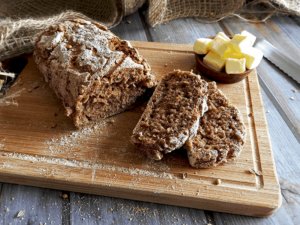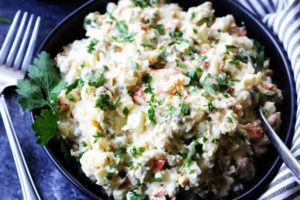Live to One Hundred and One – Eat like a Peasant to live like a Lord.
Eat like a peasant in Sardinia, Russia or Japan, people who are the healthiest around the world.
What is peasant cuisine? One definition is those dishes specific to a particular culture made from accessible and inexpensive ingredients. Focusing on ‘living only off what you can grow’, the traditional peasant diet was therefore predominantly plant-based, with wholegrains (rice, barley, oats, rye) and vegetables such as potatoes being the main source of nutrition, and legumes providing the primary source of protein.
My first foray into this subject is food from Russia and Ukraine. I want to start with a traditional Russian appetizer called zakushi. The plural form of the word for appetizers is zakuski, which loosely translates as “little bites” and they are meant to soften the effects of the iced vodka or other strong potables they are served with.
The selection can be simple or it can be a real spread of salads and small plates and the tradition dates back to the czars’ tables of the 18th century. These Russian hors d’oeuvres were often served to standing guests outside the main dining room, usually buffet style or passed by waiters.
Zakuski are often described as Russia’s answer to tapas. Zakuski are often described as Russia’s answer to tapas — a little bite to have with your drink. Traditionally, when you welcome guests in from the cold (whether from the Moscow streets, or from the hundreds of miles it takes to travel to a country estate), you give them a warming shot of vodka. And to protect your stomach and palate from the harsh vodka, you quickly follow it with a bite of zakuski.
Drink vodka, eat pickles, repeat. Here is an interesting article
Salads, caviars, mushrooms, as well as various kinds of vodkas were standards . While this remains unchanged, a more modern approach is take some hearty dark sour rye bread (much more on that later), add some a mix of purchased smoked fish, caviar, hard cheeses and salamis, and a homemade bean salad, eggplant caviar, brined mushrooms, beets, tomatoes, watermelon, and bread or pastry pockets filled with meat, potato or cabbage.
This website has a nice list of some of them.
But you say, this is about peasant food, not kings.
The same principles apply. A shot of vodka and a bite to eat. Typical Russian dishes include “blinis” (buckwheat crepes, filled with potatoes, mushrooms, herring, red and black caviar, or cabbage, and rolled up and dipped in sour cream, melted butter or condensed milk); “kasha” (buckwheat porridge, sometimes mixed with mushrooms), and “pelmeni” (ravioli-like, meat-filled Siberian dumplings, often smothered with sour cream), “golubtsy” (cabbage rolls stuffed with meat), “plov” (Central-Asian style rice pilaf), “pizozhki” (fried or baked turnovers stuffed with cabbage, minced meat, mushrooms or potatoes); apple, mushroom and cabbage pies, and fruit-stuffed “pirozhki. “
Meals are typically eaten in the kitchen. A meal served to a guest at someone’s home might include a variety of cold meats, cheeses, fruits and raw vegetables from Georgia and Armenia, salmon and sturgeon from the Caspian Sea, red and black caviar served with homemade blinis, several kinds of meat pies and dumplings accompanied by many rounds of toasts with vodka and beer.
Traditional peasant food include porridge for breakfast, cabbage soup, picked cucumbers, pumpkin, salted watermelon, hot bread and butter, pickled cabbage, homemade vermicelli, mutton, chicken, cold lamb trotters, baked potatoes, wheat gruel with butter, vermicelli with dried cherries, pancakes and clotted cream
The best Russian food is served in homes, not restaurants, and includes simple, working-class, unpretentious fish or meat-and-potato dishes, and things like home-grown currants, forest-gathered pickled mushrooms, soured goat’s milk, cucumber soup, mashed potatoes, and sweet buttery pancakes with honey or strawberries.
Cabbage pie is a favorite food. Many Russians eat their brown bread with salt sprinkled on it. Herring os a popular lunch food. Great care is taken to pull out the bones. Some people have bologna sandwich for breakfast and lunch and a bx of chocolates for dinner. Russian camping food includes borscht, raw garlic, pork fat and grain alcohol mixed with river water.
A zakuski menu is not complete without at least one type of salad.
The classic Russian salad, also called the “Ensalada Rusa,” or the “Salad Olivieh,” was invented by Lucien Olivier in the 18th century for a restaurant in Moscow called Hermitage.
It was a huge hit not only in Russia but all across Eastern Europe as well.
Countries such as Bulgaria, Poland, and Ukraine have their own versions of the popular appetizer.
Its primary ingredients include potatoes, carrots, pickles, onions, peas, eggs, and a creamy dressing made with mayonnaise.
- Potatoes;
- Carrots;
- Eggs;
- Peas;
- Pickles;
- Onions;
- Ham (optional)
HOW TO MAKE RUSSIAN OLIVIER (OLIVIEH) SALAD
The preparation of the Russian Salad is very simple, however, it will require a few steps and some extra time, because vegetables and eggs need to be cooked and cooled off before the chopping.
Step 1: Place eggs in a pot of cold water. Bring to boil and cook for 10 minutes. Remove the eggs from the water and let them fully cool off before peeling.
Step 2: Place whole, unpeeled potatoes, and carrots in a pot of water. Add a teaspoon of salt and bring to boil. Cook until vegetables are fork tender for about 20-25 minutes. Remove from water and let cool off fully before peeling.
Step 3: Peel and chop the pickles (peeling is optional; I feel like they taste better in this salad without tough skin).
Step 4: Chop the onions.
Step 5: Strain and rinse canned peas.
Step 6: Peel and chop into cubes eggs, potatoes, and carrots (if using, cube your ham too).
Step 7: Place all the ingredients into a large bowl and mix all together.
Step 8: In a small bowl combine mayonnaise with mustard and pepper. Add it into the salad ingredients and mix all together.
An important tip when making Russian Salad: Do not add salt to your mayonnaise mixture. Mayonnaise, as well as Dijon mustard, have a lot of salt in it. Dress your salad first, taste it and then add salt if needed. Remember, you can ALWAYS add salt but you cannot take it away!







